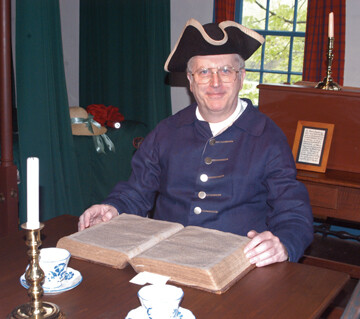
Shrine Celebrates the Spirit of Strawbridge
Believing that more people need to discover what the Rev. Jim Talley calls one of “the crown jewels of Methodism,” the United Methodist Historical Society offered a bus tour of Strawbridge Shrine and other faith-related sites in Carroll County May 2.
Touring “Strawbridge country,” close to 50 people visited The Brick Church, which was formed in 1829 by Methodist Protestants, who left the Methodist Episcopal Church because they believed that the laity needed to share power in the church with bishops and clergy.
The tour also stopped at the Evans Family Cemetery, where the first converts to Methodism in America were buried; the site of the original log meeting, erected in 1764 at the first Methodist meeting house in America; and 14 other sites at which the story of Methodism unfolded in the eighteenth and nineteenth centuries.
The highlight of the tour was the stop at the Robert Strawbridge Shine.
 Robert and Elizabeth Strawbridge emigrated to America from Ireland about 1760, where according to Methodism’s first bishop, Francis Asbury, “Mr. Strawbridge formed the first society in Maryland and America.”
Robert and Elizabeth Strawbridge emigrated to America from Ireland about 1760, where according to Methodism’s first bishop, Francis Asbury, “Mr. Strawbridge formed the first society in Maryland and America.”
Elizabeth is credited with making the first convert in the New World when she shared her faith in her kitchen with her neighbor John Evans. A recently refurbished and furnished Evans house at the Shrine site was a favorite site among the tour participants.
Although he was a layman, Strawbridge traveled as an evangelist to Virginia, Pennsylvania, New Jersey and Delaware. Elizabeth kept the farm and led the first class meeting in America, which was started in their house in 1763.
As the birthplace of American Methodism, Strawbridge Shrine holds a special place in the hearts of historians. But even more important is the Strawbridge legacy, which speaks to the church today, said the Rev. Lou Piel, chair of the conference’s committee on Archives and History, who led the tour.
“We don’t know why Robert and Elizabeth Strawbridge left and made the dangerous trip across the Atlantic to America, but we do know they had ‘a sense of vision’ that gave them courage to venture into the unknown. They were willing to take the risk,” Piel said. “They truly felt that God was on their side, or even more God was with them,” said Piel.
In visiting the Shrine, history can come to life, Piel said, and introduce itself into our present.
“Someone once said, ‘if you want to walk on water you have to get out of the boat,’” Piel told the tour group. “Robert and Elizabeth had been touched by the living water of Jesus Christ and even though they did not have all the pieces together, they were willing to take the risk. There are times when we need to get out of the boat, both individually and as a church. Rather than stay in the comfortable pew or pulpit, we know that God is with us and we need to venture forth.”
Following the tour, participants met at Westminster UMC for the annual meeting of the conference Historical Society. R. Bryce Workman, the curator of the New Windsor Heritage Committee and author of two books about the Strawbridge Shrine and Evans House, was the guest speaker.
The Rev. Emora Brannan, of Grace UMC in Baltimore who chairs the historical society, spoke in his remarks about how essential history and memory are to faith and discipleship.
Drawing on passages about the first Passover from Exodus, he referred to history as “a special kind of remembering” that lifts up God’s work in the life of an individual and what the Lord has done for us collectively.
“It’s vital to the Discipleship Adventure of the church to remember what the Lord has done for us to empower us to walk with the Lord into the future,” he said.
At the meeting, eight life memberships were recognized and awards for church histories were given out. The 2009 award for church history in the large church category was St. Paul’s UMC in Kensington. Benevola UMC in Boonsboro won in the medium-size church category for church history and Eastern UMC in Baltimore won in the smaller membership category.
Archivist Wanda Hall encouraged all churches to send their programs, news clippings and other items about church events and anniversaries to Lovely Lane so they can be filed for future researchers.
Also on the agenda were plans for hosting the Northeastern Jurisdiction Commission on Archives and History May 5-7, 2011, in New Windsor, where participants will explore Strawbridge Country in-depth.

Login/Register to leave comment